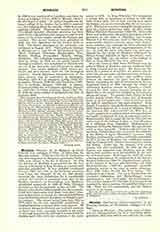

Munkacs, Diocese of, in Hungary, of Greek Catholic Rite, suffragan of Gran. It dates from the fifteenth century. Until then the Greek Ruthenians who had emigrated to Hungary a generation before, 1254, were subject to the See of Przemysl. In 1458 the Diocese of Munkacs is mentioned for the first time in a document of King Mathias as a parish with episcopal jurisdiction. It was probably established between 1439 and 1458, as the document mentions that Lucas, the occupant of the see, had already exercised the usual jurisdiction for a considerable period. Its history is connected with that of the Basilian monastery at Csernekhegy near Munkacs, established supposedly in 1360 by Duke Theodore Koriatovics, but demonstrably as late as 1418. The history of the diocese falls naturally into three periods. Until 1641, when union with Rome took place, Munkacs endeavored to extend its episcopal jurisdiction over the thirteen districts (Komitate) of Hungary, later its territory. The second period lasts from 1641 to 1771, when the see was canonically established. A third period brings its history down to the present. Of its history during the fifteenth and sixteenth centuries we know very little, especially in regard to the mode of episcopal appointment, although it was probably by election until 1561, with the exception of the nomination in 1458. In King Wladislaw II’s documents a certain John is mentioned as bishop in 1491 and 1498; thence until 1551 we hear nothing more about the bishops, nor are we even sure that the see was occupied. The first document recording the actual appointment of a bishop dates from 1623. In 1641, under Bishop Theodore Tharassovics (1639-48), union with Rome was facilitated by the wish to have done with dependence on the lords of Munkacs, but George Rikbczi I of Transylvania, Lord of Munkacs, being unfavorably disposed towards union, took Tharassovics prisoner, and, although the latter obtained his freedom in 1642, he did not regain possession of the see. In 1649 the union with Rome was again proclaimed by the clergy of Munkacs influenced by Bishop George Jakusich of Eger; henceforth, especially from 1689, date the efforts of the bishops of Eger to bring Munkacs into close subjection.
After the union of 1649, Peter Parthenius was appointed Bishop of Munkacs, and was confirmed both by King Leopold and the pope. His death was followed by a period of decadence: the diocese was divided into several parts, administered more or less independently of one another, and conflicts arose between the emperor, the pope, and the Rakoczi family, concerning the right of nomination to the see. Appointed bishop in 1689 through the efforts of Archbishop Kolonics, Joseph de Camelis, a Greek, devoted his chief energy towards fostering the religious life of the people and extirpating incontinence. among the clergy. To promote these objects he held twelve synods within three years, that of Szatmar being of special importance. After Cameliss death the right of appointment was again disputed. King Joseph I appointed Joseph Hodermarszky bishop in 1705; Francis Rakbczi II, as Lord of Munkacs, filled the episcopal office independently; the Holy See, on its part, appointed an administrator, not regarding the see legally established for lack of canonical creation. Hodermarszky had to resign the see in 1715, and the endeavors of the bishops of Eger to treat Munkacs as a suffragan thus triumphed. Hodermarszkys successor, Gennadius Bizanczi (1716-33), had already acted as vicar Apostolic. Both he and still more his successor, Michael Olsayszky, contested the authority of the Bishop of Eger; Olsayszkys successor, John Bradacs, continued the conflict, and finally triumphed. In 1771 the See of Munkacs was established canonically by Clement XIV, Brad acs becoming first canonical bishop. Under him the chapter, with seven canons, was also established. In 1816 the See of Eperjes was separated from Munkacs, and in 1856 ninety-four parishes were incorporated in the new See of Szamosujvar. Basil Popovics (1837-64) made a lasting impression on the religious life of the diocese; Stephen Pankovics (1866-74) displayed great activity in the domain of diocesan administration, and John Pasztelyi Kovacs (1879-94) performed especially prominent service in the cause of public education. Since 1894 Julius Firczak has been bishop. The residence is at Ungvar. The see is divided into two vicariates (Marmaros and Hajdu Dorog), seven archdeaneries, and forty eight vice archdeaneries. The parishes number 387, the right of patronage being exercised by ninety patrons, the parochial clergy over 500. There are five monasteries, and the chapter consists of six canons.
A. ALDASY

